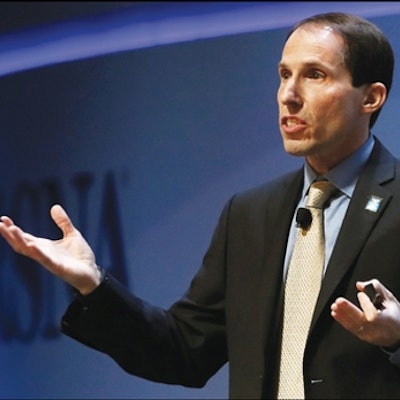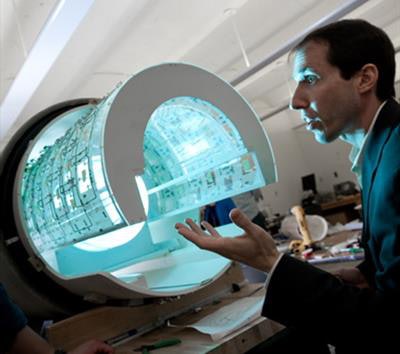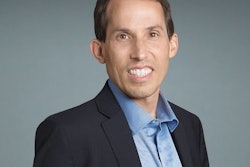
The imaging artificial intelligence (AI) landscape is like the Wild West right now, but the International Society for Magnetic Resonance in Medicine (ISMRM) can act as the sheriff by providing vital scientific rigor, balance, and a healthy dose of skepticism, according to Dr. Daniel Sodickson, PhD, the society's president.
"There's some lawlessness, but also a very wide frontier with many possibilities," he said in an interview on Monday with AuntMinnieEurope.com. "AI does not mean simply taking algorithms and applying them -- we need to tailor the algorithms to the individual clinical case."
 Patients must not see MRI as a loud tunnel that brings bad news, Dr. Daniel Sodickson said.
Patients must not see MRI as a loud tunnel that brings bad news, Dr. Daniel Sodickson said.Speaking in Paris from this week's joint congress of the ISMRM and the European Society of MR in Medicine and Biology (ESMRMB), Sodickson admitted there is a lot of hype and "creative ferment" about AI, but the technology does promise to change in fundamental ways how MR scanners are designed, built, and used clinically.
Because the society has a global, multidisciplinary membership of more than 7,400 people representing a diverse range of different stakeholders, he is convinced it is particularly well placed to challenge assumptions and cut through the hype.
"It gives me some heart that there are scientists out there who are asking, 'Are you sure about that?' " noted Sodickson, who is vice-chair for research in the department of radiology at New York University Langone Medical Center. "Our members tend to understand the biological context in which AI needs to be seen."
Paris draws the crowds
By the end of 17 June, 6,057 professional attendees had registered onsite at ISMRM/ESMRMB 2018, which is a new record high for the meeting, and the final figure, including exhibitors and others, is likely to approach 8,000, he added.
Gender equality and unconscious bias are important issues at the meeting, and will be addressed in the Presidential Lecture on 20 June by Curt Rice, PhD, head of the Committee for Gender Balance and Diversity in Research and president of Oslo Metropolitan University in Norway. Rice has advised members of the Nobel Foundation's committees on the challenges faced in moving toward better gender balance in the awarding of the Nobel Prizes.
One example of imbalance is the ISMRM's own list of gold medalists, Sodickson said. Although two women (Dr. Christiane Kuhl in 2015 and Sharmila Majumdar, PhD, in 2016) are among the recent recipients, only four of the total number of 80 award-winners are women.
"We know that women have played an essential role in the ongoing development of our field," he pointed out. "In a year marked by long-overdue upheavals in the global conversation about gender and diversity, we hope that attendees of our meeting will take full advantage of this opportunity to look inward, and forward, together."
Ironically, though, both gold medalists at ISMRM 2018 -- announced on 18 June -- are U.S.-based men: Susumu Mori, PhD, professor at the Center of MR Microimaging in Johns Hopkins University, and Dwight Nishimura, PhD, professor of electrical engineering at Stanford University.
Tariffs on China
Sodickson said it's too early yet to determine what impact, if any, the U.S. government's decision to impose tariffs on equipment from China is likely to have on the MRI market. This decision was confirmed by the Trump administration last Friday. The number of Chinese members of the ISMRM is rising fast and companies from China are among the exhibitors in Paris, but the emphasis is on displaying innovations rather than selling equipment, he noted.
Another unresolved issue is the safety of gadolinium-based contrast agents for MRI.
"This is area of ongoing interest for us, and there are sessions about it being held this week," he said. "It's important to remember the value of these agents and not to deny our patients of the potential benefits from using them."
Sodickson said ISMRM also is making a concerted effort to reach out to clinical radiologists and convince them the society is relevant for both them. His overall aim, though, is to tell the story of MRI in a more positive way to physicians from other medical disciplines, as well as patients and the media.
"I want to avoid people thinking of MRI as a loud tunnel that my doctor says I must go into and will give me bad news," he said.




















